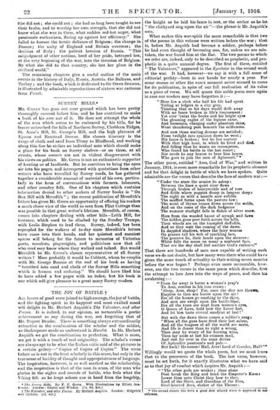SURREY HILLS.*
MR. GREEN 1123 gone out over ground which has been pretty thoroughly covered before him, and he has contrived to make a book of his own out of it. He does not attempt the whole of the area which seems to be embraced by his title, for he leaves untouched the hills of Northern Surrey, Chobham Ridges, St. Anne's Hill, St. George's Hill, and the high plateaux of Epsom and Banstead Downs. His chosen itinerary is the range of chalk and sand from Titsey to Hindhead, and working along this line he strikes an individual note which should make a place for his book on Surrey shelves—or on those, at all events, whose owners are not in violent disagreement with his views on politics. Mr. Green is not an enthusiastic supporter of hunting or of landlords. But he contrives to bring the open air into his pages, and interspersed with quOtations from other writers who have travelled by Surrey roads, he has gathered together a considerable amount of material of his own, particu- larly in the form of conversations with farmers, labourers, and other country folk. One of his chapters which contains information denied to other makers of Surrey books is " On Box Hill with Meredith " ; the recent publication of Meredith's letters has given Mr. Green an opportunity of offering his readers a much closer view of the world as seen from Flint Cottage than was possible in that great writer's lifetime. Meredith, of course, comes into chapters dealing with other hills—Leith Hill, for instance, which used to be climbed by the Sunday Tramps, with Leslie Stephen to lead them. Surrey, indeed, has been repeopled for the walkers of to-day since Meredith's letters have come into their hands, and her quietest and sunniest spaces will belong for the future to memories of Victorian. poets, novelists, playwrights, and politicians now that all who read may know where they walked and talked. But would Meredith be Mr. Green's chosen representative of all Surrey writers ? More probably it would be Cobbett, whom he couples with Mr. George Bourne at the end of his book as having " breathed into sand and chalk of the Surrey Hills something which is human and enduring." We should have liked him to have added a few pages with an index, but his book is one which will give pleasure to a great many Surrey readers,










































 Previous page
Previous page